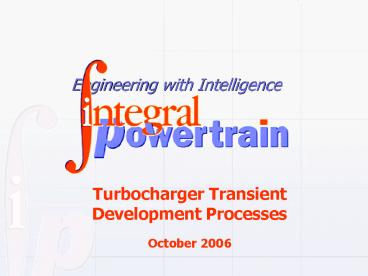Turbocharger Transient Development Processes - PowerPoint PPT Presentation
1 / 10
Title:
Turbocharger Transient Development Processes
Description:
Engineering with Intelligence. Turbocharger Transient Development ... http://automotive.iut.ac.ir/fsae/uploads/urn_nbn_se_kth_diva-216-1__fulltex t.pdf ... – PowerPoint PPT presentation
Number of Views:213
Avg rating:3.0/5.0
Title: Turbocharger Transient Development Processes
1
Turbocharger Transient Development Processes
- October 2006
2
State of the Art Turbocharging
- Key features
- Variable cam phasing DI injection
optimal gas dynamics - Reduced EGR
- Reduced charge temperature
- Very high volumetric efficiency(gt1)
- Excellent knocking performance
- Avoidance of surge condition
- gt20 reduction of Tmax speed
- Enhancements using twin scroll or pulse converter
- Variable geometry systems in the near future
3
The Transient Challenge
- Transient behaviour is very different from
steady-state - Exhaust to inlet pressure difference strongly
affects gas exchange - Turbine operating point (temperature, speed,
flow) - System characterisation problematic using
conventional approaches (testing, sim, etc) - Complex multi-variable calibration optimisation
required. Strong effects from VCP, spark timing
and fuel injection. VGT adds further complexity - Mastering this area can lead to critical
improvements to driving behaviour
4
IPs Inside the Transient Toolset
- Three components in one
- Physical Simulation
- Powertrain in vehicle model for evaluation of
hardware / control options
- Testing
- Test process for transient characterisation
- Response Characterisation
- Transient calibration optimisation (DoE based)
5
Testing inside the T/C Transient
- Steady replication of transient event
- Engine volumetric efficiency characterisation
- Turbine efficiency characterisation
- Optimisation of valve events, fuelling and spark
timing
6
Modelling
- 1-D Strengths / limitations
- Accurate predictive simulation of pressure
conditions in cylinder, inlet and exhaust using
wastegate control (free float behaviour more
problematic) - Detailed scavenging behaviour requires extensive
test correlation - Turbine work not truly predictive. Emulation
possible with extensive correlation - Cycle resolved turbine inlet temperature
- Efficiency modifiers typically up to 30 in
either direction - Integration of control system strategy possible
but not seamless - High levels of skill and time resources required,
even for steady state modelling - Click here for detailed discussion of 1-D applied
to turbocharged SI
http//automotive.iut.ac.ir/fsae/uploads/urn_nbn_s
e_kth_diva-216-1__fulltext.pdf
Essential tool for understanding gas exchange and
energy transfer mechanisms Not suitable for
routine system optimisation
7
Modelling
- IP Matlab / Simulink model
- Characterisation / emulation using
zero-dimensional bulk properties for gas exchange
and turbine work. - Rapid automatic correlation when used with
inside the transient test process. - Fully dynamic in-vehicle simulation of hardware
and control system strategies. - Capable of supporting development for transient
variable cam-phaser strategies, turbocharger
size, variable turbine control, gearing change - Efficient use of time and skill resource
A practical approach to support development of
optimal driving behaviour
8
Optimising the Transient
- Combining inside the transient test process
with advanced DoE - Response to critical variables mapped under
transient representative conditions (VCP, spark
timing, fuel injection and VGT if fitted) - Multi-variable functions constructed for torque
and available turbine work - Torque response profile mathematically optimised
for minimum lag, maximum tip-in torque or
according to target metrics
9
Turbo Engineering Toolsets
- O-D Application tool
- Rapid matching and performance calculations for
all types of pressure charging system (gasoline,
diesel, single and multi-stage)
- 3-D CFD
- Compressor inlet design to optimise effective
map-width
- 1-D Simulation
- Understand detailed gas exchange mechanisms /
sensitivities
- IP Dynamic vehicle simulation
- Unique MatlabSimulink model covering total
vehicle hardware and control system - Accurate replication of transient events
- System optimisation
- Mobile test bed
- On-vehicle high-speed transient data acquisition
10
Conclusion
- Sophisticated and Effective Approach
- Developed in-house for use on OE programs
- Processes proven on in-production programs
- Ready to help you achieve the desired response!































